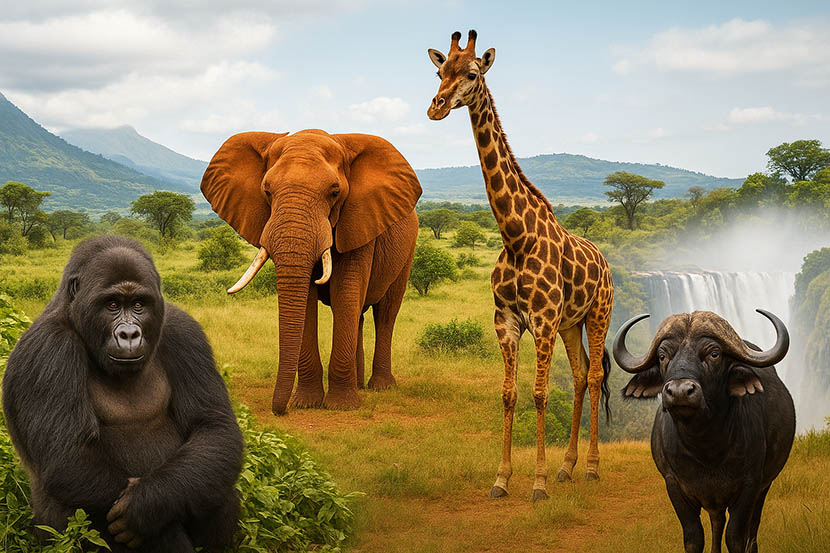<> Viral of Today <>
Home » AFRICA » Rawanda Unites with South Africa, Kenya, Zimbabwe in Bringing Six Hundred Ninety Eight Million USD from International Visitors like US, Canada, China, Australia, New Zealand Wednesday, June 4, 2025Rwanda unites with South Africa, Kenya, and Zimbabwe in rewriting the narrative of African tourism. Together, these nations are setting the stage for something massive—bringing in six hundred ninety-eight million USD from international visitors. From the US, Canada, China, Australia, to New Zealand, global travelers are choosing Africa’s heartlands. Rwanda, South Africa, Kenya, and Zimbabwe are not just riding the wave; they are creating it.Meanwhile, each destination elevates its offerings—from gorilla trekking in Rwanda to safari wonders in Kenya, wine trails in South Africa, and Victoria Falls in Zimbabwe. But here’s the twist—this surge in six hundred ninety-eight million USD isn’t by chance. It’s strategy. It’s bold partnerships. And it’s cultural magnetism. As Rwanda unites with these powerhouse countries, the travel world is taking notice. What happens next in this tourism evolution? The journey begins here. The revenue speaks volumes. And the numbers are just the beginning.Rwanda’s Record-Breaking Tourism Rise Redefines Africa’s Global Travel LandscapeIn 2024, Rwanda made waves across the global travel map, raking in an estimated $698 million from international visitors. The momentum is clear, the trajectory is bold, and the strategy is working. From gorilla trekking to high-stakes business summits, Rwanda’s tourism sector has evolved into a formidable economic force—anchored in sustainability, innovation, and global connectivity.With strong projections for 2025 and a 13% growth forecast, Rwanda is not just rising—it’s becoming a model for how emerging nations can reshape their tourism narratives on the world stage.Gorilla Tourism Powers Rwanda’s Tourism EngineThe jewel in Rwanda’s tourism crown remains its gorilla tourism sector. Generating $200 million in revenue alone, this singular attraction now contributes 1% of Rwanda’s entire GDP. Beyond the dollars, the impact runs deep. Local communities benefit directly from eco-tourism programs, with revenue reinvested into education, infrastructure, and conservation.These immersive wildlife experiences are more than bucket-list moments—they are economic lifelines and cultural connectors.Visitors from around the world trek into the lush forests of Volcanoes National Park to witness endangered mountain gorillas up close. Each encounter fuels job creation, environmental awareness, and global respect for Rwanda’s commitment to conservation.Conferences, Meetings, and Events Drive High-Value VisitsRwanda isn’t relying solely on its natural beauty. It has rapidly become a magnet for Meetings, Incentives, Conferences, and Exhibitions (MICE), with Kigali ranking second in Africa for international events.With world-class venues like the Kigali Convention Centre, BK Arena, Intare Conference Arena, and the newly revamped Amahoro Stadium, the country hosted 115 high-profile events in 2024, welcoming over 52,000 delegates.From international health summits to major sporting competitions, Rwanda’s infrastructure and reliability are now drawing organizations from across the globe. This MICE-led growth is transforming Rwanda from a tourism destination into a global business hub.Visa on Arrival and RwandAir Expand AccessRwanda’s progressive visa-on-arrival policy for all nationalities has removed a major barrier to travel. It sends a clear message: the country is open, welcoming, and ready for the world.Meanwhile, RwandAir, the national carrier, continues to expand its network, providing critical airlift to and from key markets across Africa, Europe, and the Middle East. This accessibility is fueling growth not just in leisure travel but also in business and diaspora-related movement.It’s a strategic pairing—easy entry and reliable air access—that has elevated Rwanda’s position as a seamless travel destination.Domestic Tourism Gains TractionWhile international travel grabs headlines, domestic tourism is rising steadily, thanks to cultural festivals, family reunions, and educational visits. According to the Rwanda Development Board (RDB), travel between friends and relatives now accounts for 5% of tourism activity, while educational trips represent 16%.These segments support internal movement and spread economic benefits beyond major tourist zones. They also foster national pride, cultural preservation, and local engagement in the tourism economy.Licensing, Regulation, and Market MaturityIn 2024 alone, Rwanda licensed 95 new tourism entities, signaling a maturing market with growing investor confidence. This expansion spans hotels, tour operators, event planners, and more, creating a diversified tourism ecosystem ready to handle increasing demand.Regulation, training, and innovation remain central to the country’s approach—helping ensure that quality and sustainability remain front and center even as visitor numbers grow.“Visit Rwanda” Strategy Scores Big with Global Sports DealsRwanda’s most attention-grabbing move, however, may be its bold entry into the world of international sports partnerships. Through its “Visit Rwanda” branding campaign, the nation has secured top-tier exposure with football clubs like Arsenal, Bayern Munich, and now Atlético de Madrid.The new deal with Atlético de Madrid, launched in 2024, places Rwanda’s name before millions of La Liga viewers around the world. This isn’t just a logo on a sleeve—it’s a calculated move in Rwanda’s playbook to fuse tourism, diplomacy, and investment strategy.The partnership highlights Rwanda’s long-term vision of sports as a gateway to global engagement, trust-building, and cultural exchange.Tourism as a Pillar of National DevelopmentAs Rwanda’s tourism narrative evolves, it remains deeply rooted in a broader development mission. The sector supports job creation, GDP growth, community empowerment, and global brand visibility.With a target of $700 million in tourism revenue for 2025, Rwanda is positioning itself not just as a safari stopover, but as a sustainable tourism powerhouse with the infrastructure, strategy, and vision to support long-term growth.Kigali’s rise as a preferred destination for global gatherings, paired with rural conservation wins, offers a powerful duality—one that many countries aspire to, but few execute this effectively.How African Nations Are Powering Global Travel: South Africa, Kenya, Zimbabwe Drive Tourism Ties with U.S., Canada, China, Australia, and New ZealandIn a rapidly evolving global tourism market, African nations are stepping up to shape outbound travel patterns, build international bridges, and rewrite their roles on the world stage. Countries like South Africa, Kenya, and Zimbabwe are not just attracting visitors—they’re now sending millions of their own travelers abroad, significantly boosting tourism to the United States, Canada, China, Australia, and New Zealand.This emerging trend marks a significant shift in global travel flows, driven by stronger diplomatic ties, relaxed visa policies, rising middle-class populations, and a hunger for cross-cultural exploration.South Africa: A Tourism Powerhouse Redefining Global ConnectionsSouth Africa has long been a magnet for tourists, but now it’s also making headlines as a leading outbound tourism source. With deepening ties to the U.S., Canada, Australia, and even China, South Africans are increasingly booking international vacations, business trips, and educational exchanges.In 2017, the U.S. and Canada were among the top five overseas countries visited by South African tourists, according to Wikipedia. Meanwhile, Australia’s Department of Foreign Affairs and Trade reported trade with South Africa exceeding A$3 billion in 2021—fueling business travel between the nations.South Africa’s growing affluence and cosmopolitan aspirations are shaping its global footprint, with outbound travelers seeking both leisure and opportunity in equal measure.Kenya: Building Bridges from East Africa to the WorldKenya’s commitment to international tourism goes far beyond its stunning safaris and savannahs. Diplomatic outposts in Australia and strategic visa agreements have elevated Kenya’s position as a major player in outbound tourism.According to Wikipedia, Kenya maintains a high commission in Canberra, Australia—established in 1983—solidifying a decades-long relationship that has helped boost travel between the two countries. In recent years, more Kenyans have traveled to North America and Oceania, drawn by educational opportunities, conferences, and increasingly, by a desire for leisure and exploration.Kenya is also strengthening its reach into New Zealand, where diplomatic accreditation via Canberra supports growing ties, tourism, and migration.Zimbabwe and China: A Case Study in Eastward ExpansionZimbabwe has embraced a bold “Look East” policy aimed at deepening economic and tourism ties with China. As one of Africa’s most vocal supporters of Chinese partnerships, Zimbabwe has actively pursued outbound tourism strategies focused on medical, business, and leisure segments.This push is paying off. TravelandTourWorld reports that Zimbabwean authorities are targeting Chinese travel markets with specialized offerings—further demonstrating how Africa is diversifying its global partnerships.Meanwhile, South Africa continues to court Chinese tourists through simplified visa processes, including the Trusted Tour Operator Scheme that facilitates faster approvals. These moves are shaping a powerful tourism corridor between Africa and Asia.New Zealand and Australia: New Frontiers for African TravelersSouth Africa and Kenya are also expanding ties with New Zealand, where mutual diplomatic relationships promote smoother travel experiences. With embassies and high commissions fostering cultural exchange and economic partnerships, outbound tourism from Africa to Oceania is poised for remarkable growth.Rising connectivity through airlines, international education programs, and visa-on-arrival policies has made Australia and New Zealand attractive destinations for African travelers eager to experience new worlds.The Bigger PictureAfrica’s growing influence on global tourism is not just about numbers—it’s about presence, visibility, and cultural exchange. These outbound flows are deepening global understanding, expanding markets, and proving that Africa is not just a destination—but a powerful driver of global tourism.Conclusion: Rwanda’s Tourism Future Looks Bold and BrightWith $698 million in 2024 revenue and no signs of slowing, Rwanda is on a fast track to tourism excellence. It has built a brand that goes beyond nature—it champions innovation, connectivity, and strategic visibility.From gorilla treks to stadium spotlights, Rwanda’s rise is no accident. It’s a masterclass in how a small country can achieve global impact through clarity of vision, national unity, and a commitment to excellence.For travelers, investors, and tourism professionals, Rwanda is no longer a hidden gem—it’s a glowing beacon at the heart of Africa’s new tourism frontier.Tags: Africa travel trends, Australia, Canada, china, international relations, kenya, new zealand, outbound tourism, South Africa, United States, visa policy, Zimbabwe
This information will surprise you!
See also
- Read until the end to discover everything.
- Important information you need to know.
- Interesting facts and helpful tips.
Conclusion
Did you enjoy the news? Keep following us daily!

